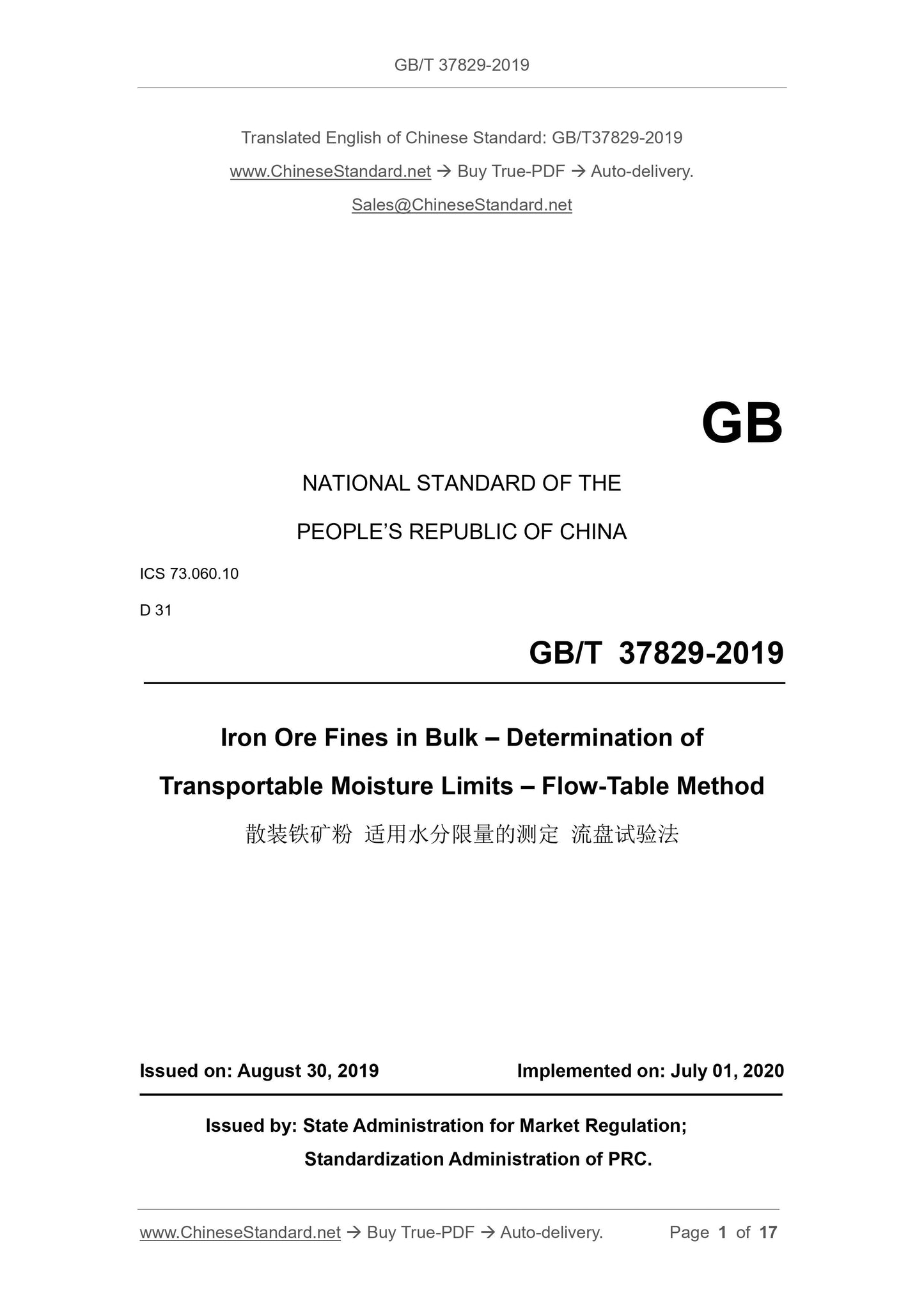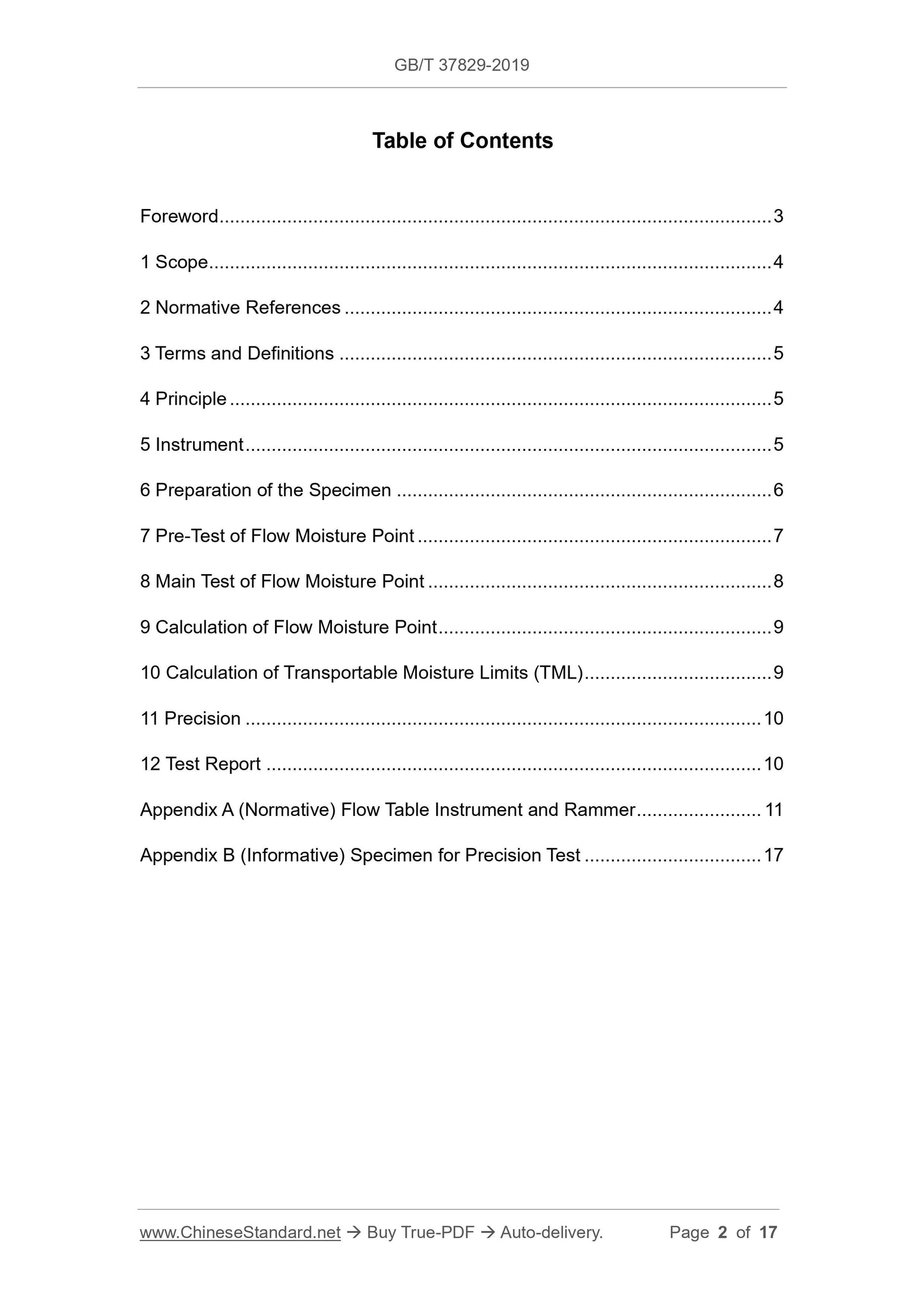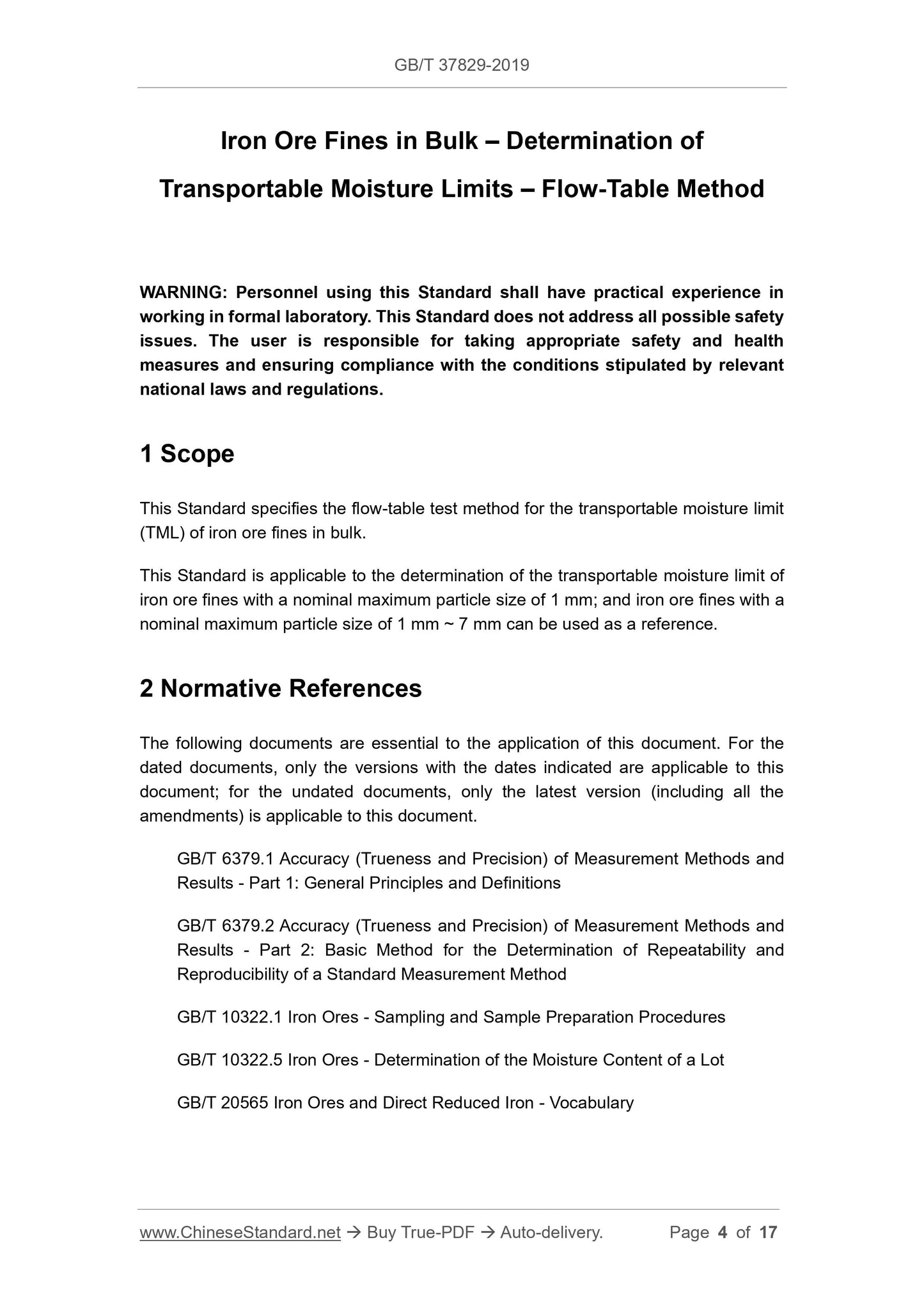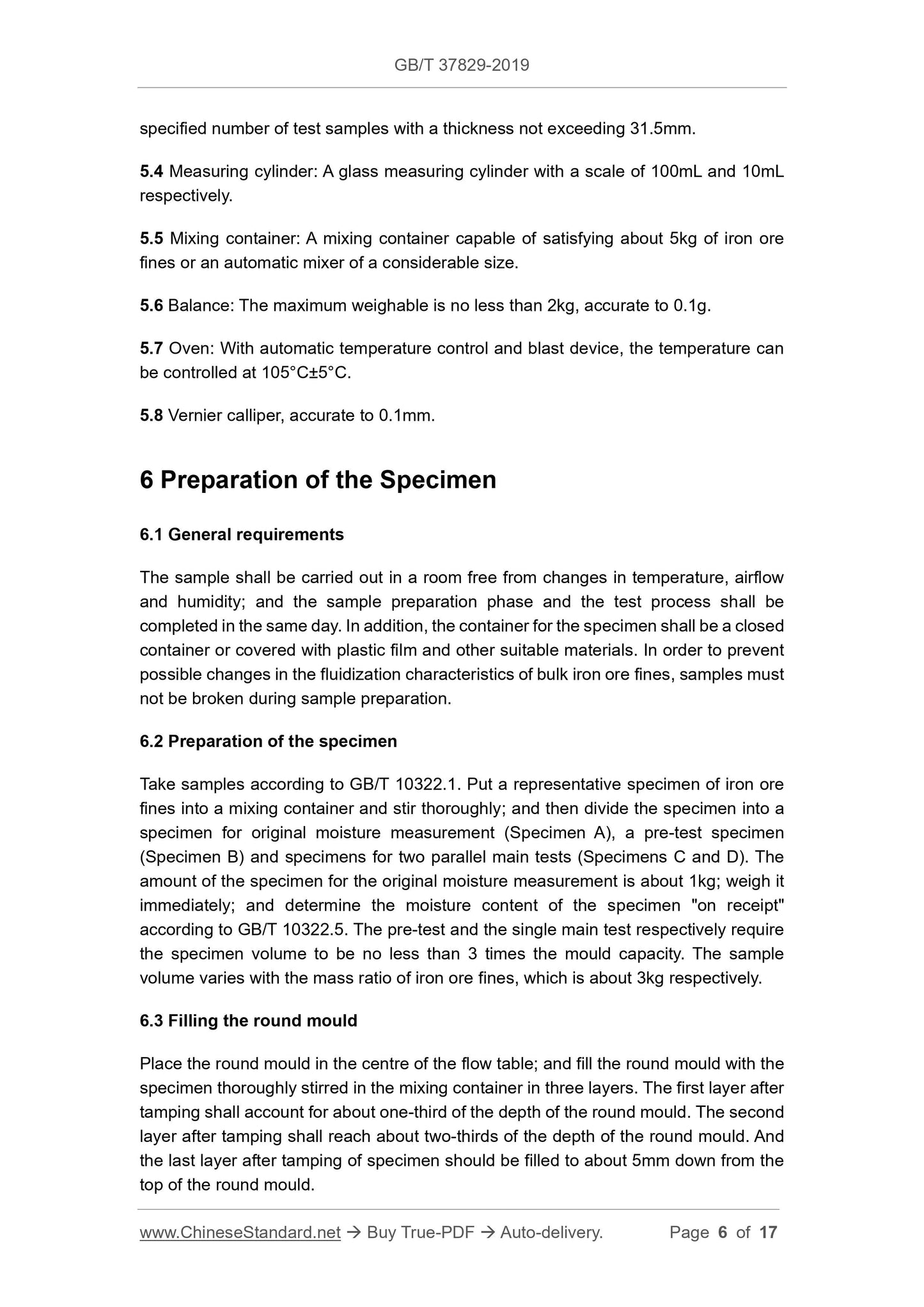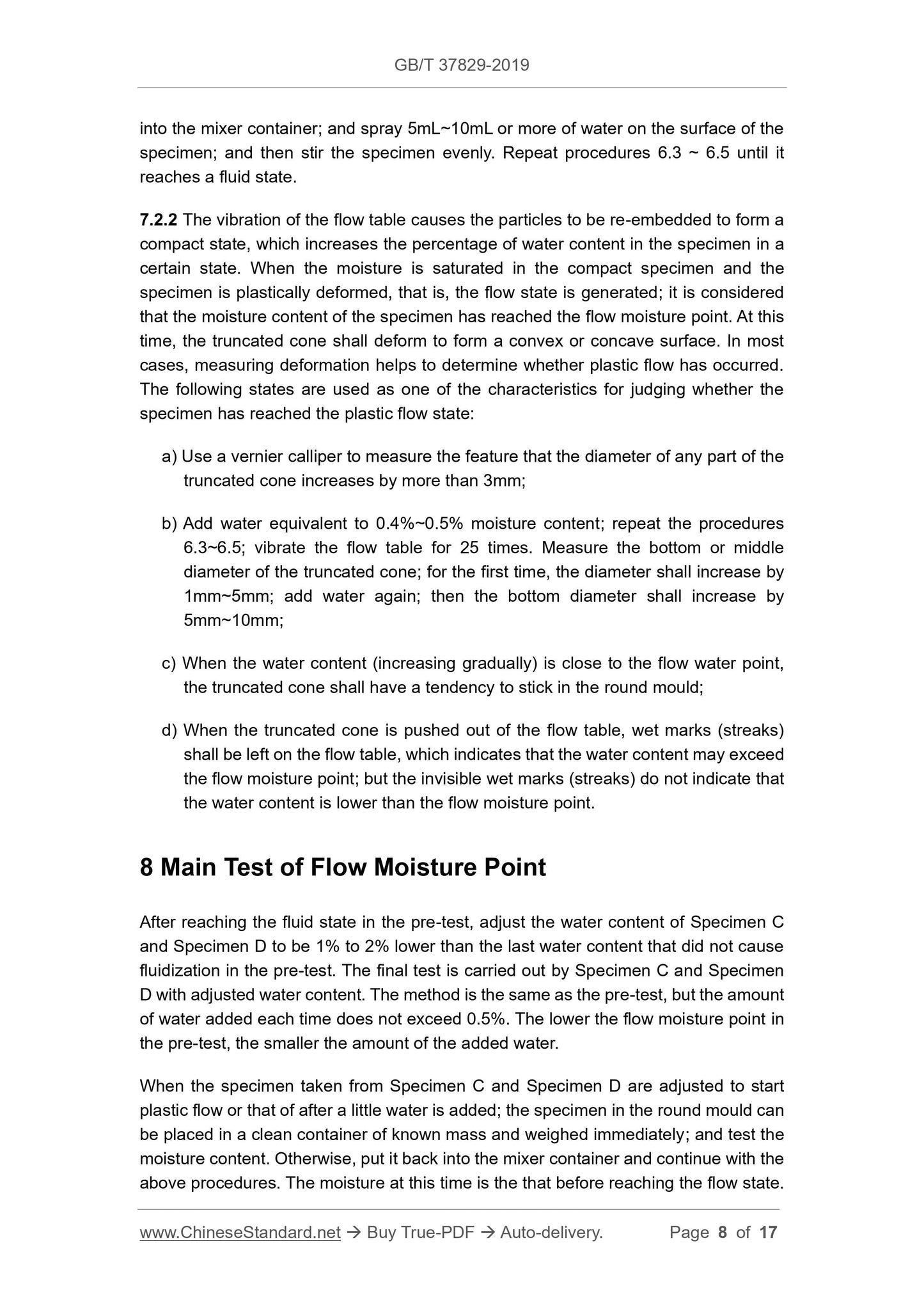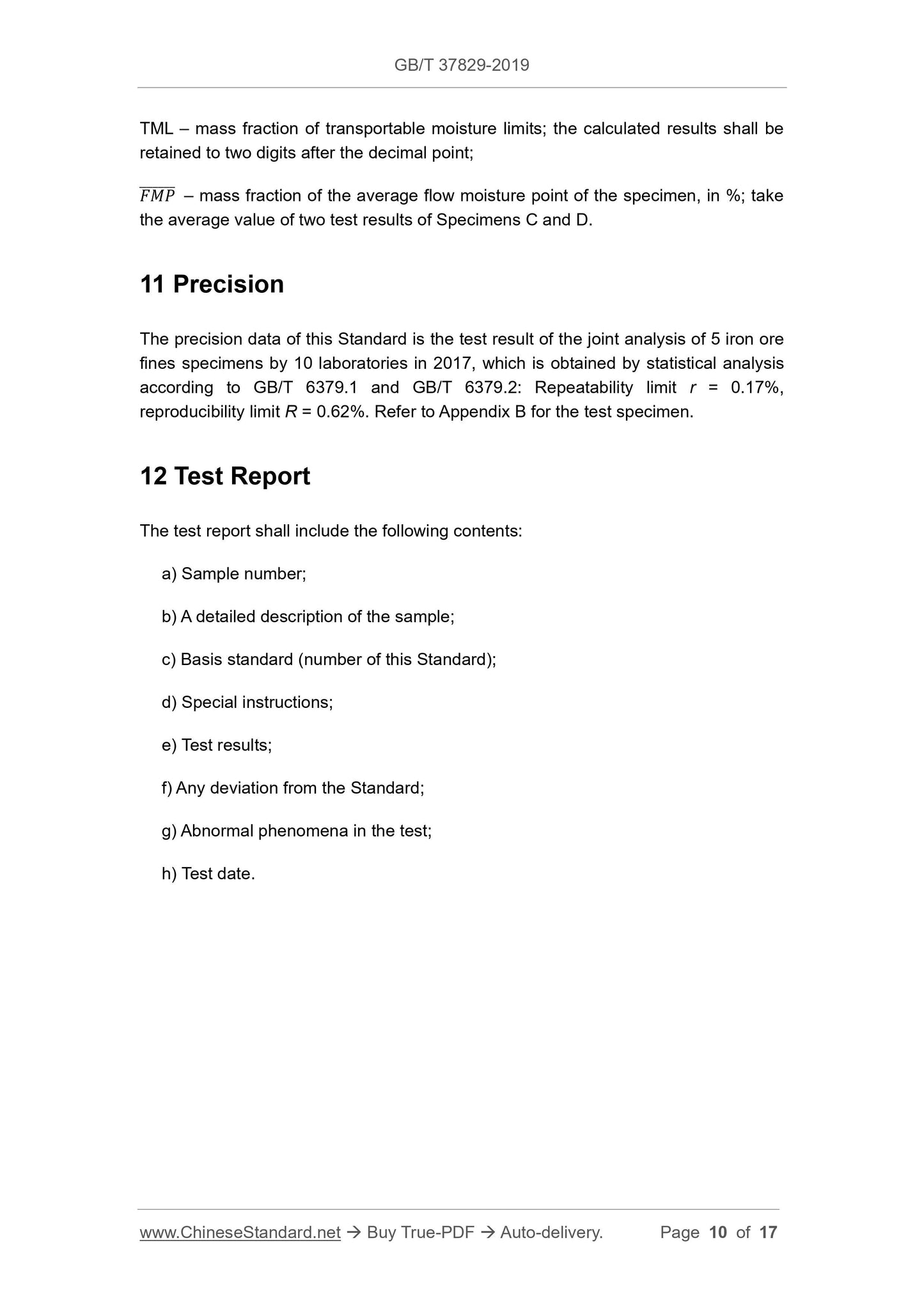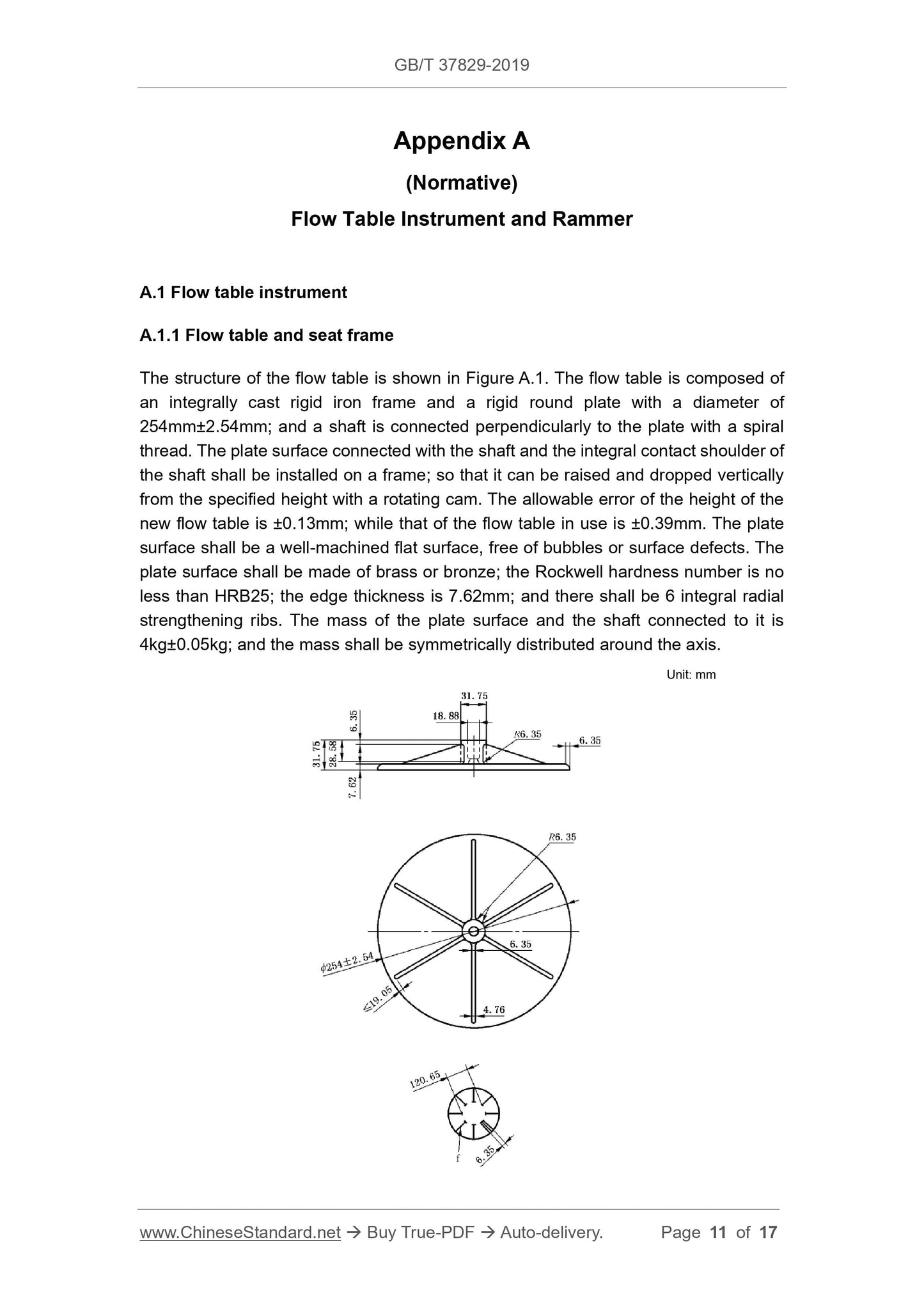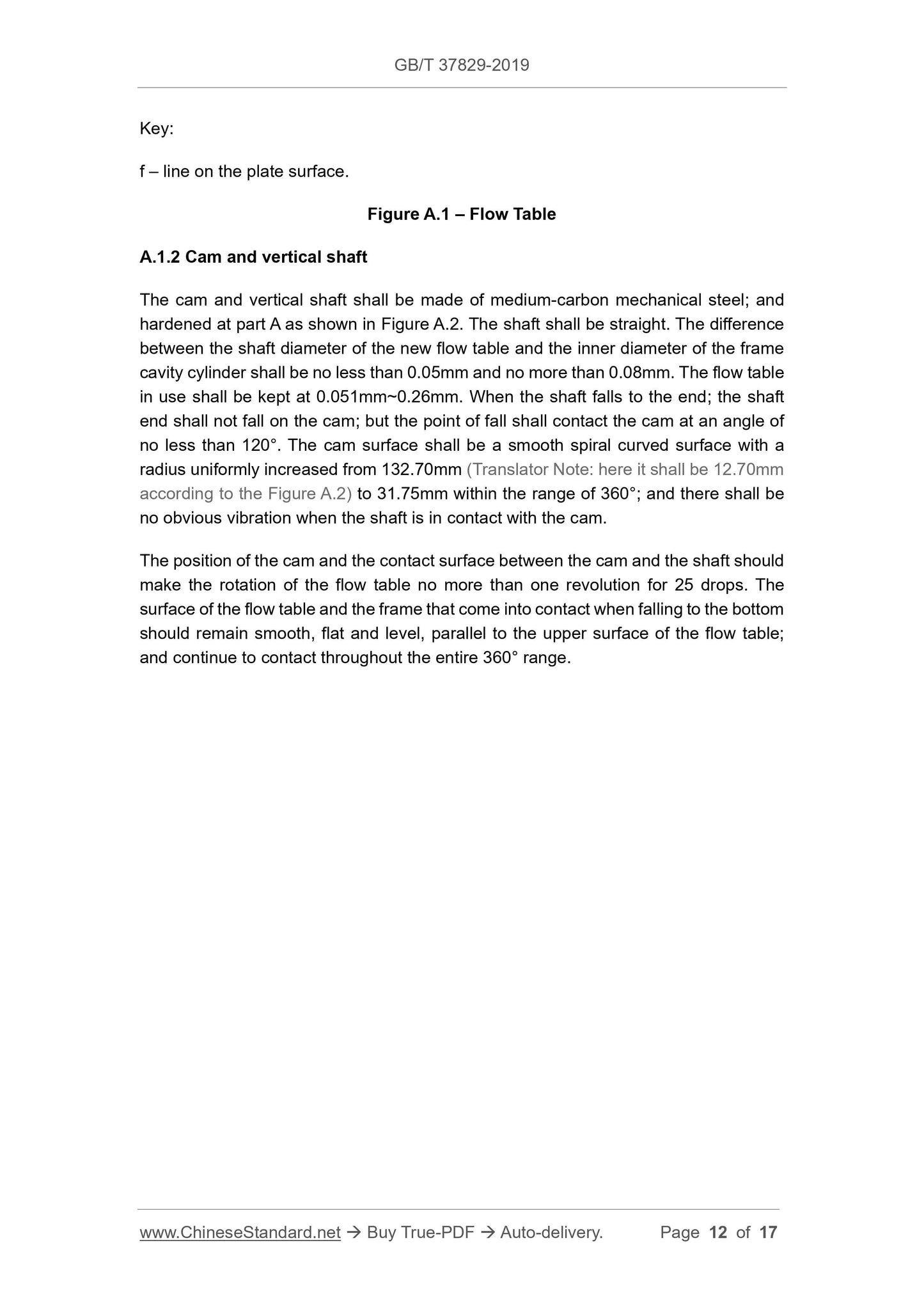1
/
of
8
PayPal, credit cards. Download editable-PDF and invoice in 1 second!
GB/T 37829-2019 English PDF (GBT37829-2019)
GB/T 37829-2019 English PDF (GBT37829-2019)
Regular price
$230.00 USD
Regular price
Sale price
$230.00 USD
Unit price
/
per
Shipping calculated at checkout.
Couldn't load pickup availability
Delivery: 3 seconds. Download true-PDF + Invoice.
Get QUOTATION in 1-minute: Click GB/T 37829-2019
Historical versions: GB/T 37829-2019
Preview True-PDF (Reload/Scroll if blank)
GB/T 37829-2019: Iron ore fines in bulk -- Determination of transportable moisture limits -- Flow-table method
GB/T 37829-2019
GB
NATIONAL STANDARD OF THE
PEOPLE’S REPUBLIC OF CHINA
ICS 73.060.10
D 31
Iron Ore Fines in Bulk – Determination of
Transportable Moisture Limits – Flow-Table Method
ISSUED ON: AUGUST 30, 2019
IMPLEMENTED ON: JULY 01, 2020
Issued by: State Administration for Market Regulation;
Standardization Administration of PRC.
Table of Contents
Foreword ... 3
1 Scope ... 4
2 Normative References ... 4
3 Terms and Definitions ... 5
4 Principle ... 5
5 Instrument ... 5
6 Preparation of the Specimen ... 6
7 Pre-Test of Flow Moisture Point ... 7
8 Main Test of Flow Moisture Point ... 8
9 Calculation of Flow Moisture Point ... 9
10 Calculation of Transportable Moisture Limits (TML) ... 9
11 Precision ... 10
12 Test Report ... 10
Appendix A (Normative) Flow Table Instrument and Rammer ... 11
Appendix B (Informative) Specimen for Precision Test ... 17
Iron Ore Fines in Bulk – Determination of
Transportable Moisture Limits – Flow-Table Method
WARNING: Personnel using this Standard shall have practical experience in
working in formal laboratory. This Standard does not address all possible safety
issues. The user is responsible for taking appropriate safety and health
measures and ensuring compliance with the conditions stipulated by relevant
national laws and regulations.
1 Scope
This Standard specifies the flow-table test method for the transportable moisture limit
(TML) of iron ore fines in bulk.
This Standard is applicable to the determination of the transportable moisture limit of
iron ore fines with a nominal maximum particle size of 1 mm; and iron ore fines with a
nominal maximum particle size of 1 mm ~ 7 mm can be used as a reference.
2 Normative References
The following documents are essential to the application of this document. For the
dated documents, only the versions with the dates indicated are applicable to this
document; for the undated documents, only the latest version (including all the
amendments) is applicable to this document.
GB/T 6379.1 Accuracy (Trueness and Precision) of Measurement Methods and
Results - Part 1: General Principles and Definitions
GB/T 6379.2 Accuracy (Trueness and Precision) of Measurement Methods and
Results - Part 2: Basic Method for the Determination of Repeatability and
Reproducibility of a Standard Measurement Method
GB/T 10322.1 Iron Ores - Sampling and Sample Preparation Procedures
GB/T 10322.5 Iron Ores - Determination of the Moisture Content of a Lot
GB/T 20565 Iron Ores and Direct Reduced Iron - Vocabulary
specified number of test samples with a thickness not exceeding 31.5mm.
5.4 Measuring cylinder: A glass measuring cylinder with a scale of 100mL and 10mL
respectively.
5.5 Mixing container: A mixing container capable of satisfying about 5kg of iron ore
fines or an automatic mixer of a considerable size.
5.6 Balance: The maximum weighable is no less than 2kg, accurate to 0.1g.
5.7 Oven: With automatic temperature control and blast device, the temperature can
be controlled at 105°C±5°C.
5.8 Vernier calliper, accurate to 0.1mm.
6 Preparation of the Specimen
6.1 General requirements
The sample shall be carried out in a room free from changes in temperature, airflow
and humidity; and the sample preparation phase and the test process shall be
completed in the same day. In addition, the container for the specimen shall be a closed
container or covered with plastic film and other suitable materials. In order to prevent
possible changes in the fluidization characteristics of bulk iron ore fines, samples must
not be broken during sample preparation.
6.2 Preparation of the specimen
Take samples according to GB/T 10322.1. Put a representative specimen of iron ore
fines into a mixing container and stir thoroughly; and then divide the specimen into a
specimen for original moisture measurement (Specimen A), a pre-test specimen
(Specimen B) and specimens for two parallel main tests (Specimens C and D). The
amount of the specimen for the original moisture measurement is about 1kg; weigh it
immediately; and determine the moisture content of the specimen "on receipt"
according to GB/T 10322.5. The pre-test and the single main test respectively require
the specimen volume to be no less than 3 times the mould capacity. The sample
volume varies with the mass ratio of iron ore fines, which is about 3kg respectively.
6.3 Filling the round mould
Place the round mould in the centre of the flow table; and fill the round mould with the
specimen thoroughly stirred in the mixing container in three layers. The first layer after
tamping shall account for about one-third of the depth of the round mould. The second
layer after tamping shall reach about two-thirds of the depth of the round mould. And
the last layer after tamping of specimen should be filled to about 5mm down from the
top of the round mould.
into the mixer container; and spray 5mL~10mL or more of water on the surface of the
specimen; and then stir the specimen evenly. Repeat procedures 6.3 ~ 6.5 until it
reaches a fluid state.
7.2.2 The vibration of the flow table causes the particles to be re-embedded to form a
compact state, which increases the percentage of water content in the specimen in a
certain state. When the moisture is saturated in the compact specimen and the
specimen is plastically deformed, that is, the flow state is generated; it is considered
that the moisture content of the specimen has reached the flow moisture point. At this
time, the truncated cone shall deform to form a convex or concave surface. In most
cases, measuring deformation helps to determine whether plastic flow has occurred.
The following states are used as one of the characteristics for judging whether the
specimen has reached the plastic flow state:
a) Use a vernier calliper to measure the feature that the diameter of any part of the
truncated cone increases by more than 3mm;
b) Add water equivalent to 0.4%~0.5% moisture content; repeat the procedures
6.3~6.5; vibrate the flow table for 25 times. Measure the bottom or middle
diameter of the truncated cone; for the first time, the diameter shall increase by
1mm~5mm; add water again; then the bottom diameter shall increase by
5mm~10mm;
c) When the water content (increasing gradually) is close to the flow water point,
the truncated cone shall have a tendency to stick in the round mould;
d) When the truncated cone is pushed out of the flow table, wet marks (streaks)
shall be left on the flow table, which indicates that the water content may exceed
the flow moisture point; but the invisible wet marks (streaks) do not indicate that
the water content is lower than the flow moisture point.
8 Main Test of Flow Moisture Point
After reaching the fluid state in the pre-test, adjust the water content of Specimen C
and Specimen D to be 1% to 2% lower than the last water content that did not cause
fluidization in the pre-test. The final test is carried out by Specimen C and Specimen
D with adjusted water content. The method is the same as the pre-test, but the amount
of water added each time does not exceed 0.5%. The lower the flow moisture point in
the pre-test, the smaller the amount of the added water.
When the specimen taken from Specimen C and Specimen D are adjusted to start
plastic flow or that of after a little water is added; the specimen in the round mould can
be placed in a clean container of known mass and weighed immediately; and test the...
Get QUOTATION in 1-minute: Click GB/T 37829-2019
Historical versions: GB/T 37829-2019
Preview True-PDF (Reload/Scroll if blank)
GB/T 37829-2019: Iron ore fines in bulk -- Determination of transportable moisture limits -- Flow-table method
GB/T 37829-2019
GB
NATIONAL STANDARD OF THE
PEOPLE’S REPUBLIC OF CHINA
ICS 73.060.10
D 31
Iron Ore Fines in Bulk – Determination of
Transportable Moisture Limits – Flow-Table Method
ISSUED ON: AUGUST 30, 2019
IMPLEMENTED ON: JULY 01, 2020
Issued by: State Administration for Market Regulation;
Standardization Administration of PRC.
Table of Contents
Foreword ... 3
1 Scope ... 4
2 Normative References ... 4
3 Terms and Definitions ... 5
4 Principle ... 5
5 Instrument ... 5
6 Preparation of the Specimen ... 6
7 Pre-Test of Flow Moisture Point ... 7
8 Main Test of Flow Moisture Point ... 8
9 Calculation of Flow Moisture Point ... 9
10 Calculation of Transportable Moisture Limits (TML) ... 9
11 Precision ... 10
12 Test Report ... 10
Appendix A (Normative) Flow Table Instrument and Rammer ... 11
Appendix B (Informative) Specimen for Precision Test ... 17
Iron Ore Fines in Bulk – Determination of
Transportable Moisture Limits – Flow-Table Method
WARNING: Personnel using this Standard shall have practical experience in
working in formal laboratory. This Standard does not address all possible safety
issues. The user is responsible for taking appropriate safety and health
measures and ensuring compliance with the conditions stipulated by relevant
national laws and regulations.
1 Scope
This Standard specifies the flow-table test method for the transportable moisture limit
(TML) of iron ore fines in bulk.
This Standard is applicable to the determination of the transportable moisture limit of
iron ore fines with a nominal maximum particle size of 1 mm; and iron ore fines with a
nominal maximum particle size of 1 mm ~ 7 mm can be used as a reference.
2 Normative References
The following documents are essential to the application of this document. For the
dated documents, only the versions with the dates indicated are applicable to this
document; for the undated documents, only the latest version (including all the
amendments) is applicable to this document.
GB/T 6379.1 Accuracy (Trueness and Precision) of Measurement Methods and
Results - Part 1: General Principles and Definitions
GB/T 6379.2 Accuracy (Trueness and Precision) of Measurement Methods and
Results - Part 2: Basic Method for the Determination of Repeatability and
Reproducibility of a Standard Measurement Method
GB/T 10322.1 Iron Ores - Sampling and Sample Preparation Procedures
GB/T 10322.5 Iron Ores - Determination of the Moisture Content of a Lot
GB/T 20565 Iron Ores and Direct Reduced Iron - Vocabulary
specified number of test samples with a thickness not exceeding 31.5mm.
5.4 Measuring cylinder: A glass measuring cylinder with a scale of 100mL and 10mL
respectively.
5.5 Mixing container: A mixing container capable of satisfying about 5kg of iron ore
fines or an automatic mixer of a considerable size.
5.6 Balance: The maximum weighable is no less than 2kg, accurate to 0.1g.
5.7 Oven: With automatic temperature control and blast device, the temperature can
be controlled at 105°C±5°C.
5.8 Vernier calliper, accurate to 0.1mm.
6 Preparation of the Specimen
6.1 General requirements
The sample shall be carried out in a room free from changes in temperature, airflow
and humidity; and the sample preparation phase and the test process shall be
completed in the same day. In addition, the container for the specimen shall be a closed
container or covered with plastic film and other suitable materials. In order to prevent
possible changes in the fluidization characteristics of bulk iron ore fines, samples must
not be broken during sample preparation.
6.2 Preparation of the specimen
Take samples according to GB/T 10322.1. Put a representative specimen of iron ore
fines into a mixing container and stir thoroughly; and then divide the specimen into a
specimen for original moisture measurement (Specimen A), a pre-test specimen
(Specimen B) and specimens for two parallel main tests (Specimens C and D). The
amount of the specimen for the original moisture measurement is about 1kg; weigh it
immediately; and determine the moisture content of the specimen "on receipt"
according to GB/T 10322.5. The pre-test and the single main test respectively require
the specimen volume to be no less than 3 times the mould capacity. The sample
volume varies with the mass ratio of iron ore fines, which is about 3kg respectively.
6.3 Filling the round mould
Place the round mould in the centre of the flow table; and fill the round mould with the
specimen thoroughly stirred in the mixing container in three layers. The first layer after
tamping shall account for about one-third of the depth of the round mould. The second
layer after tamping shall reach about two-thirds of the depth of the round mould. And
the last layer after tamping of specimen should be filled to about 5mm down from the
top of the round mould.
into the mixer container; and spray 5mL~10mL or more of water on the surface of the
specimen; and then stir the specimen evenly. Repeat procedures 6.3 ~ 6.5 until it
reaches a fluid state.
7.2.2 The vibration of the flow table causes the particles to be re-embedded to form a
compact state, which increases the percentage of water content in the specimen in a
certain state. When the moisture is saturated in the compact specimen and the
specimen is plastically deformed, that is, the flow state is generated; it is considered
that the moisture content of the specimen has reached the flow moisture point. At this
time, the truncated cone shall deform to form a convex or concave surface. In most
cases, measuring deformation helps to determine whether plastic flow has occurred.
The following states are used as one of the characteristics for judging whether the
specimen has reached the plastic flow state:
a) Use a vernier calliper to measure the feature that the diameter of any part of the
truncated cone increases by more than 3mm;
b) Add water equivalent to 0.4%~0.5% moisture content; repeat the procedures
6.3~6.5; vibrate the flow table for 25 times. Measure the bottom or middle
diameter of the truncated cone; for the first time, the diameter shall increase by
1mm~5mm; add water again; then the bottom diameter shall increase by
5mm~10mm;
c) When the water content (increasing gradually) is close to the flow water point,
the truncated cone shall have a tendency to stick in the round mould;
d) When the truncated cone is pushed out of the flow table, wet marks (streaks)
shall be left on the flow table, which indicates that the water content may exceed
the flow moisture point; but the invisible wet marks (streaks) do not indicate that
the water content is lower than the flow moisture point.
8 Main Test of Flow Moisture Point
After reaching the fluid state in the pre-test, adjust the water content of Specimen C
and Specimen D to be 1% to 2% lower than the last water content that did not cause
fluidization in the pre-test. The final test is carried out by Specimen C and Specimen
D with adjusted water content. The method is the same as the pre-test, but the amount
of water added each time does not exceed 0.5%. The lower the flow moisture point in
the pre-test, the smaller the amount of the added water.
When the specimen taken from Specimen C and Specimen D are adjusted to start
plastic flow or that of after a little water is added; the specimen in the round mould can
be placed in a clean container of known mass and weighed immediately; and test the...
Share
